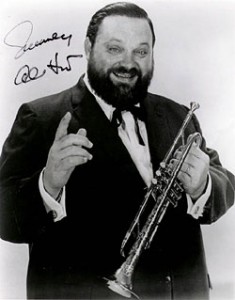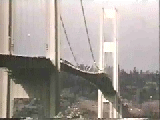My poor Tundra is dying a slow death and I needed something to get me around. This 2001 Jeep Grand Cherokee is perfect!
Daily Archives: November 7, 2011
07
Nov 11
Al Hirt: Born This Day in 1922
 Al Hirt
Al Hirt
November 7, 1922 – April 27, 1999
Al Hirt was an American trumpeter and bandleader. He is best remembered for his million selling recordings of “Java”, and the accompanying album, Honey in the Horn (1963). His nicknames included ‘Jumbo’ and ‘The Round Mound of Sound’. Al was a member of The Louisiana Music Hall of Fame.
Alois Maxwell Hirt was born in New Orleans, Louisiana, the son of a police officer. At the age of six, he was given his first trumpet, which had been purchased at a local pawnshop. He would play in the Junior Police Band with the children of Alcide Nunez, and by the age of 16, Hirt was playing professionally, often with his friend Pete Fountain. During this time, he was hired to play at the local horse racing track, beginning a six-decade connection to the sport.
Hirt’s virtuoso dexterity and fine tone on his instrument soon attracted the attention of national labels and signed with RCA Victor Records. Hirt posted twenty two albums on the Billboard charts in the 1950s and 1960s. The albums Honey In The Horn and Cotton Candy were both in the Top 10 best sellers for 1964, the same year Hirt scored a hit single with his cover of Allen Toussaint’s tune “Java” (Billboard #4), and later won a Grammy Award for the same recording. Both Honey in the Horn and “Java” sold over one million copies, and were awarded gold discs.
His 1964 hit “Java” was used as the soundtrack to a recurring Muppet sketch that was performed on several variety shows as well as episode 122 of The Muppet Show.
07
Nov 11
Galloping Gertie
The 1940 Tacoma Narrows Bridge was the first incarnation of the Tacoma Narrows Bridge, a suspension bridge in the U.S. state of Washington that spanned the Tacoma Narrows strait of Puget Sound between Tacoma and the Kitsap Peninsula. It opened to traffic on July 1, 1940, and dramatically collapsed into Puget Sound on November 7 of the same year. At the time of its construction (and its destruction), the bridge was the third longest suspension bridge in the world in terms of main span length, behind the Golden Gate Bridge and the George Washington Bridge.
Construction on the bridge began in September 1938. From the time the deck was built, it began to move vertically in windy conditions, which led to construction workers giving the bridge the nickname Galloping Gertie. The motion was observed even when the bridge opened to the public. Several measures aimed at stopping the motion were ineffective, and the bridge’s main span finally collapsed under 40-mile-per-hour (64 km/h) wind conditions the morning of November 7, 1940.
Following the collapse, the United States’ involvement in World War II delayed plans to replace the bridge. The portions of the bridge still standing after the collapse, including the towers and cables, were dismantled and sold as scrap metal. Nearly 10 years after the bridge collapsed, a new Tacoma Narrows Bridge opened in the same location, using the original bridge’s tower pedestals and cable anchorages. The portion of the bridge that fell into the water now serves as an artificial reef.
The bridge’s collapse had a lasting effect on science and engineering. In many physics textbooks, the event is presented as an example of elementary forced resonance with the wind providing an external periodic frequency that matched the natural structural frequency, though its actual cause of failure was aeroelastic flutter. Its failure also boosted research in the field of bridge aerodynamics-aeroelastics, the study of which has influenced the designs of all the world’s great long-span bridges built since 1940.
Source: http://en.wikipedia.org/wiki/Tacoma_Narrows_Bridge_(1940)


